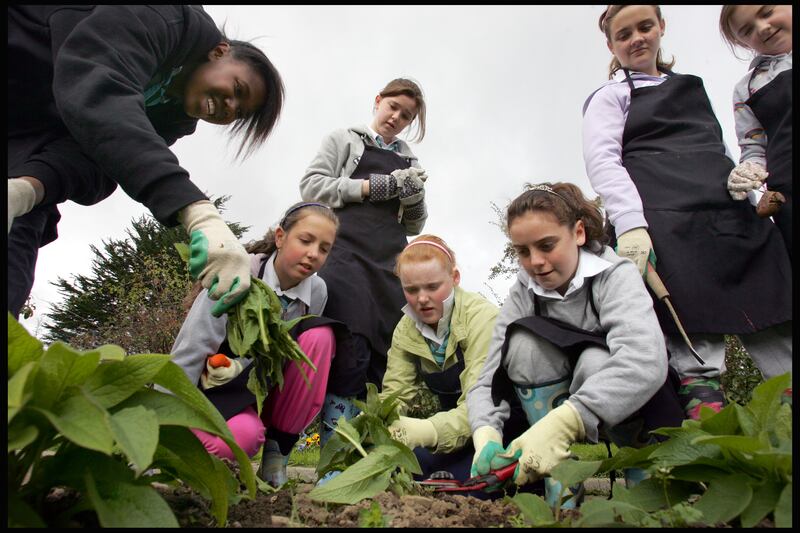It sprang up from nothing, as usual, and as a leafy tower a metre high, hung out its pink and purple bells for the bees. Symphytum officinale, or comfrey, totemistic plant of organic gardeners, still insists on its root space outside the kitchen window.
This is not, it must be said, the wild comfrey of Ireland’s damp riverbanks and woodlands — or, indeed, any self-seeding sort that, in cultivated ground, runs riot. Mine is the sterile, well-behaved hybrid Symphytum officinale x uplandicum “Bocking 14″.
This Russian comfrey was introduced to Britain in the 19th century by Henry Doubleday, and the big-leaved Bocking 14 cultivar was developed in the 1950s by Lawrence D Hills, founder of the Henry Doubleday Research Association.
All this belonged to the exciting mystique of the organic movement, growing internationally in the mid 20th century in opposition to intensive, chemical-laden agriculture. It became focused in Ireland in the 1970s around young British settlers, growing their vegetables in the unpromising soil of the Co Leitrim hills, and in the first stirrings of permaculture, the organic system from Australia.
READ MORE
Comfrey already had high regard in the lost herbal subculture of rural Ireland as Lus na gCnámh mBriste, or knitbone, and a poultice of its black, sticky root has, indeed, dealt most effectively with our own occasional bruises and stings.
What matters in organic horticulture is that the taproot goes deep into the soil, up to two metres, retrieving inaccessible minerals as nutrients for the plant’s fast-growing, hairy leaves. A stand of comfrey, readily multiplied by chunks of root, becomes the “forever” plant for any organic grower.
The leaves can be cut several times a year and used as a fertilising mulch, an enriching compost, or dissolved into water as (a very smelly) tomato feed. They contain twice as much potassium as manure. Their alkaloids, however, can be toxic to mammals, which brings warnings against drinking comfrey tea or using the plant as feed for livestock.

Ireland’s organic growers are often of strong conviction but not at all the eccentrics they might have been thought even a few decades ago. Then, the prospect of growing vegetables commercially without chemical fertilisers, pesticides and herbicides could seem foolishly exotic and uneconomic. But its principles wouldn’t go away.
The spread of local country markets and a buoyant appetite for “natural” food and milk products have helped to foster some 1,800 organic producers on some 72,000 hectares of land. All have had certification of their soil and methods by the Irish Organic Association or Irish Organic Trust.
Away from vegetable growing, however, the share of Irish organic farming is one of the lowest in Europe. The Department of Agriculture, Food and the Marine, now with a Green Minister of State, Pippa Hackett, has been trying to catch up.
Its five-year Organic Farming Scheme offers payments towards the costs of a conversion period that may last two years or more, and a lower grant when farms are “detoxed” to full organic status. Last year, however, assistance budgeted for up to 500 new farmers attracted only 317 applicants.
This year’s scheme, which opened and closed in early spring, had higher payments and attracted 380 applicants. They will add another 17,000 hectares to organic farming.
Dr Oliver Moore of UCC, a leading analyst of farming policy, has pointed to the popularity of Irish organic milk, yogurt and cheese. These, he notes, are produced by some 50 organic dairy farmers out of more than 18,000 of the conventional sort. He blames this reluctant development on a lack of State-employed organic advisers and the low rate of spending towards the Government’s own organic target of 7 per cent of farming.
Last month the European Parliament gave overwhelming support to the commission’s “farm to fork” plan to increase organic farming by 2030, for its benefits to biodiversity, sustainable food, lower greenhouse gas and rural employment.
Dr Moore fears this is “pie in the sky” without immediate, active measures. He wants Ireland to spend far more on organic marketing, quoting the €20 billion organic market in European countries. He also urges active state investment in weaning farmers from traditional farming attitudes.
The higher employment on organic farms, he says, comes from “replacing chemicals with hands.” But as the president of Macra na Feirme, John Keane, has responded, it’s the intensive labour that “turns off” young farmers from going organic.
Grow-your-own organic gardeners, meanwhile, are taking gloves and shears to yet another cut of comfrey, the generous plant that ignores wars and human crises and never puts up its price.














